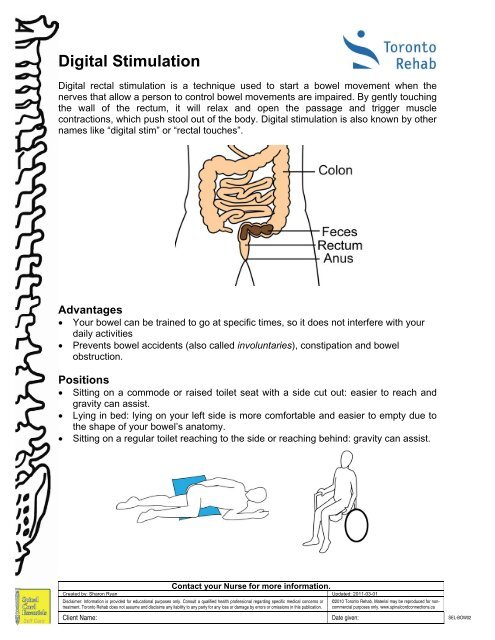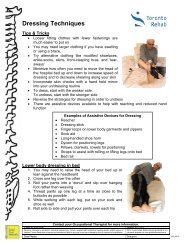Digital Stimulation - Spinal Cord Connections
Digital Stimulation - Spinal Cord Connections
Digital Stimulation - Spinal Cord Connections
Create successful ePaper yourself
Turn your PDF publications into a flip-book with our unique Google optimized e-Paper software.
<strong>Digital</strong> <strong>Stimulation</strong><br />
<strong>Digital</strong> rectal stimulation is a technique used to start a bowel movement when the<br />
nerves that allow a person to control bowel movements are impaired. By gently touching<br />
the wall of the rectum, it will relax and open the passage and trigger muscle<br />
contractions, which push stool out of the body. <strong>Digital</strong> stimulation is also known by other<br />
names like “digital stim” or “rectal touches”.<br />
Advantages<br />
• Your bowel can be trained to go at specific times, so it does not interfere with your<br />
daily activities<br />
• Prevents bowel accidents (also called involuntaries), constipation and bowel<br />
obstruction.<br />
Positions<br />
• Sitting on a commode or raised toilet seat with a side cut out: easier to reach and<br />
gravity can assist.<br />
• Lying in bed: lying on your left side is more comfortable and easier to empty due to<br />
the shape of your bowel’s anatomy.<br />
• Sitting on a regular toilet reaching to the side or reaching behind: gravity can assist.<br />
Contact your Nurse for more information.<br />
Created by: Sharon Ryan Updated: 2011-03-01<br />
Disclaimer: Information is provided for educational purposes only. Consult a qualified health professional regarding specific medical concerns or<br />
treatment. Toronto Rehab does not assume and disclaims any liability to any party for any loss or damage by errors or omissions in this publication.<br />
©2010 Toronto Rehab. Material may be reproduced for noncommercial<br />
purposes only. www.spinalcordconnections.ca<br />
Client Name: Date given: SEL-BOW02
<strong>Digital</strong> <strong>Stimulation</strong><br />
Procedure<br />
1. Gather supplies: gloves, wet wipes, lubricant, suppository, disposable blue pads,<br />
toilet paper, and plastic bag for waste.<br />
2. Lay out disposable blue pads under your hips if you are positioned in bed.<br />
3. Wash your hands and double glove one hand.<br />
4. Position yourself properly so that you are able to reach your anus.<br />
5. Lubricate your index finger with lots of<br />
lubricant – about the size of a quarter.<br />
6. Gently insert your finger into the rectum<br />
and move your finger in a circular motion<br />
against wall of rectum, for about 30<br />
seconds. Remove your finger and wait for<br />
stool to pass. Repeat this procedure every<br />
5-10 minutes until bowel is empty.<br />
7. Wait a couple more minutes for mucous<br />
and lubricant to drain.<br />
8. Clean anus and rectal area with wet wipes<br />
and place all used supplies into a plastic<br />
bag. Dispose into waste can.<br />
Note: Always use plenty of lubricant and be gentle. If you push or rotate your finger too<br />
roughly, you can irritate or tear the lining of the rectum or the anus.<br />
Signs that your bowel movement is done<br />
1. No stool has come out after two digital stimulations at least 10 minutes apart.<br />
2. You find mucous without any stool on your gloved finger.<br />
3. The muscles in the rectum become tight again and close around your finger.<br />
Check your stool for changes.<br />
If you notice changes in the colour, quantity, or consistency of your stool there may be a<br />
problem with your bowel program. If your routine takes much more than an hour, or if<br />
you notice blood in your stool, this may also signal a problem. Contact your health care<br />
provider.<br />
Contact your Nurse for more information.<br />
Created by: Sharon Ryan Updated: 2011-03-01<br />
Disclaimer: Information is provided for educational purposes only. Consult a qualified health professional regarding specific medical concerns or<br />
treatment. Toronto Rehab does not assume and disclaims any liability to any party for any loss or damage by errors or omissions in this publication.<br />
©2010 Toronto Rehab. Material may be reproduced for noncommercial<br />
purposes only. www.spinalcordconnections.ca<br />
Client Name: Date given: SEL-BOW02
<strong>Digital</strong> <strong>Stimulation</strong><br />
Suppository insertion (if necessary)<br />
1. If you have an injury above T12, you may need to start your bowel movement by<br />
inserting a suppository. Before insertion, check first to see if the rectum is full of<br />
stool. If so, you will need to remove some by breaking it up with a lubricated finger<br />
and gently removing it by hooking. This is so you can make sure the suppository is<br />
touching the wall of the rectum.<br />
2. Lubricate the suppository and your gloved finger. Insert suppository into the rectum<br />
while lying on your left side in bed and wait 10 to 15 minutes. Inserting the<br />
suppository in bed is preferred because it may fall out if inserted while sitting up on<br />
the commode.<br />
Autonomic Dysreflexia<br />
If your injury is T6 or higher, you need to be aware of the risk of autonomic dysreflexia.<br />
This is a sudden increase in blood pressure and it can result from irritation during digital<br />
stimulation. Symptoms include headache, sweating and chills. If you become<br />
dysreflexic, stop until you are feeling better. You may continue digital stimulation by<br />
using a topical anesthetic such as xylocaine jelly mixed with lubricant (Xylocaine alone<br />
can be too harsh).<br />
If you have problems with discomfort or autonomic dysreflexia, you should contact your<br />
health care provider. If your symptoms do not go away, go to your emergency room.<br />
Tips for Staying Regular<br />
• Food high in fibre helps to move stool through bowel at a faster rate<br />
• Drinking water throughout the day helps to move stool through more easily<br />
• Regular exercise is important in order to prevent constipation<br />
Hemorrhoids<br />
A hemorrhoid is a small grape-sized swelling of tissue surrounding your anus. During<br />
digital stimulation, you may notice hemorrhoids with your finger. You may also have<br />
small amounts of blood on your finger or in your stool. If you experience hemorrhoids,<br />
talk to your doctor. You may need to use extra lubricant for digital stimulation during this<br />
period.<br />
Notes:________________________________________________________________<br />
______________________________________________________________________<br />
______________________________________________________________________<br />
Contact your Nurse for more information.<br />
Created by: Sharon Ryan Updated: 2011-03-01<br />
Disclaimer: Information is provided for educational purposes only. Consult a qualified health professional regarding specific medical concerns or<br />
treatment. Toronto Rehab does not assume and disclaims any liability to any party for any loss or damage by errors or omissions in this publication.<br />
©2010 Toronto Rehab. Material may be reproduced for noncommercial<br />
purposes only. www.spinalcordconnections.ca<br />
Client Name: Date given: SEL-BOW02



